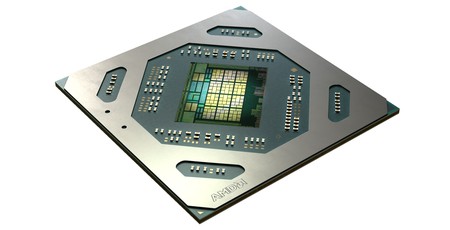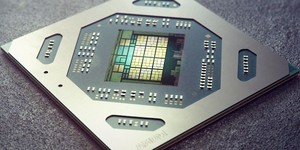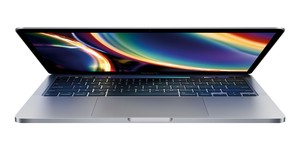
An update to the specification of the Apple MacBook Pro that sees it transition to a 16” form factor has shed light on some new Navi-based GPUs.
Announced yesterday at an Apple press event, the new MacBook Pro was partially interesting to PC gamers in that it revealed the existence of the AMD Radeon Pro 5500M and AMD Radeon Pro 5300M as available graphics options. Until that point, we only officially knew about the Radeon RX 5500 Series thanks to an announcement last month confirming the Radeon RX 5500 (with either 4GB or 8GB of GDDR6) for the desktop and the Radeon RX 5500M (4GB GDDR6 only) for mobile customers. The Radeon Pro 5500M, however, wasn’t a known entity, and neither was the Radeon Pro 5300M or indeed any AMD GPU with ‘5300’ in its name.
Since then, more details have come to light about the new GPUs and what non-Apple users can also expect to see in the near future thanks to some official clarification by AMD. Here’s the spec table that lays it out:
| AMD Radeon Pro 5500M | AMD Radeon RX 5500 | AMD Radeon RX 5500M | AMD Radeon RX 5300M | AMD Radeon Pro 5300M | |
|---|---|---|---|---|---|
| Architecture | RDNA | RDNA | RDNA | RDNA | RDNA |
| Codename | Navi 14 | Navi 14 | Navi 14 | Navi 14 | Navi 14 |
| Base GPU Clock | N/A | N/A | N/A | N/A | N/A |
| Game GPU Clock | ? | Up to 1,717MHz | Up to 1,448MHz | 1,181MHz | ? |
| Boost GPU Clock | Up to 1,300MHz | Up to 1,845MHz | Up to 1,645MHz | Up to 1,445MHz | Up to 1,250MHz |
| Compute Units | 24 | 22 | 22 | 22 | 20 |
| Stream Processors | 1,536 | 1,408 | 1,408 | 1,408 | 1,280 |
| Texture Units | 96 | 88 | 88 | 88 | 80 |
| ROPs | 32 | 32 | 32 | 32 | 32 |
| Transistors | 6.4 billion | 6.4 billion | 6.4 billion | 6.4 billion | 6.4 billion |
| Die Size | 158mm2 | 158mm2 | 158mm2 | 158mm2 | 158mm2 |
| Process Node | 7nm | 7nm | 7nm | 7nm | 7nm |
| Memory | 4GB or 8GB GDDR6 | 4GB or 8GB GDDR6 | 4GB GDDR6 | 3GB GDDR6 | 4GB GDDR6 |
| Memory Data Rate | 12Gbps | 14Gbps | 14Gbps | 14Gbps | 12Gbps |
| Memory Interface | 128-bit | 128-bit | 128-bit | 96-bit | 128-bit |
| Memory Bandwidth | 192GB/s | 224GB/s | 224GB/s | 168GB/s | 192GB/s |
| Board Power | 50W TGP | 150W | 85W TGP, configurable | TBC | 50W TGP |
As you can see, it’s a bit of a mess. Starting with the Radeon Pro 5500M, and it appears Apple is getting a bit of an exclusive in getting a fully enabled variant of the same 7nm, 6.4B-transistor, 158mm2 Navi 14 GPU that the RX 5500 parts are based on, hence the increase to 24 CUs and associated bump to the processor and texture unit count. The tight 50W TGP sees the clock speed capped at 1,300MHz, however, and that’s only the peak clock. The ‘Game Clock’, what you can expect in gaming workloads, has not been revealed. The memory is also clocked only at 12Gbps, limited the bandwidth to 192GB/s. So far, there’s no indication that PC gamers can expect anything based on a 24 CU configuration of this GPU, which is a small shame.
Next, the Apple-exclusive Pro 5300M drops to just 20 CUs and again has a tight power constraint of 50W that again impacts the clock speeds on the core and memory. However, AMD has quietly added the RX 5300M to its mobile GPU product stack, and this time we return to a 22 CU configuration, the same as the RX 5500M. The power limit is unconfirmed currently, but we assume it’s lower than the 85W RX 5500M on account of its lower Game Clock, which drops from 1,448MHz to 1,181MHz. What’s a bit pants, however, is that it only has a 3GB frame buffer and this is only served by a 96-bit memory interface, so even with the 14Gbps memory clock speed maintained, the memory bandwidth is a relatively lowly 168GB/s. AMD expects to ship this GPU in notebooks later this quarter, though we’re not aware of any units confirmed as sporting it just yet.
Lastly, there remains the question of whether AMD will bring to market a Radeon RX 5300 part for the desktop. To be fair, it hasn’t even gotten the RX 5500 to market yet, so it doesn’t appear to be in any rush to expose the Navi 14 GPU to the desktop. The folks at PCGamesN reckon the RX 5300 is likely to appear at some point based on some SKUs that were added to a recent Linux driver patch, but nothing is confirmed. Either way, we certainly hope we’re not going to see a desktop card with a 3GB frame buffer and 96-bit memory bus.

MSI MPG Velox 100R Chassis Review
October 14 2021 | 15:04








Want to comment? Please log in.